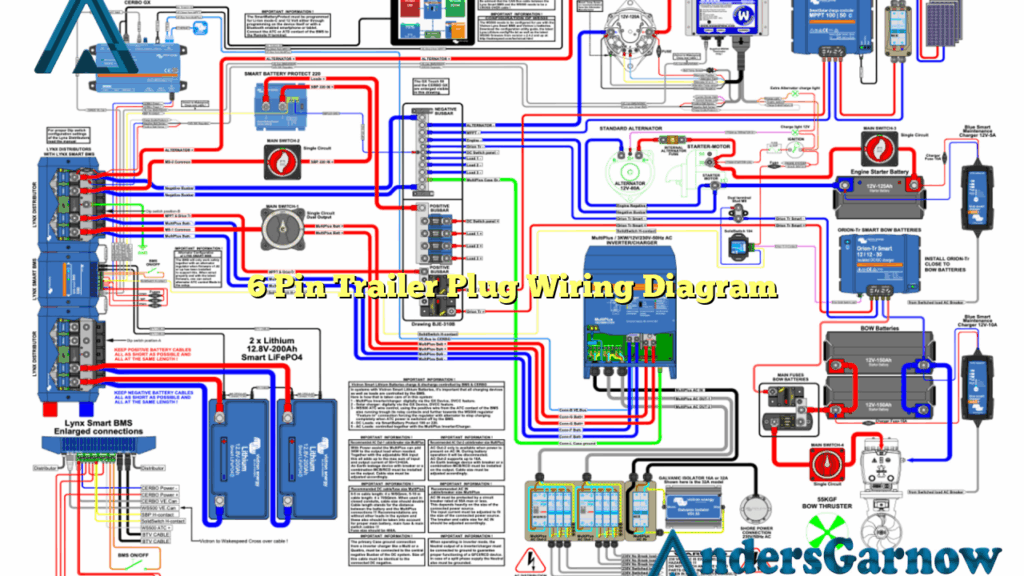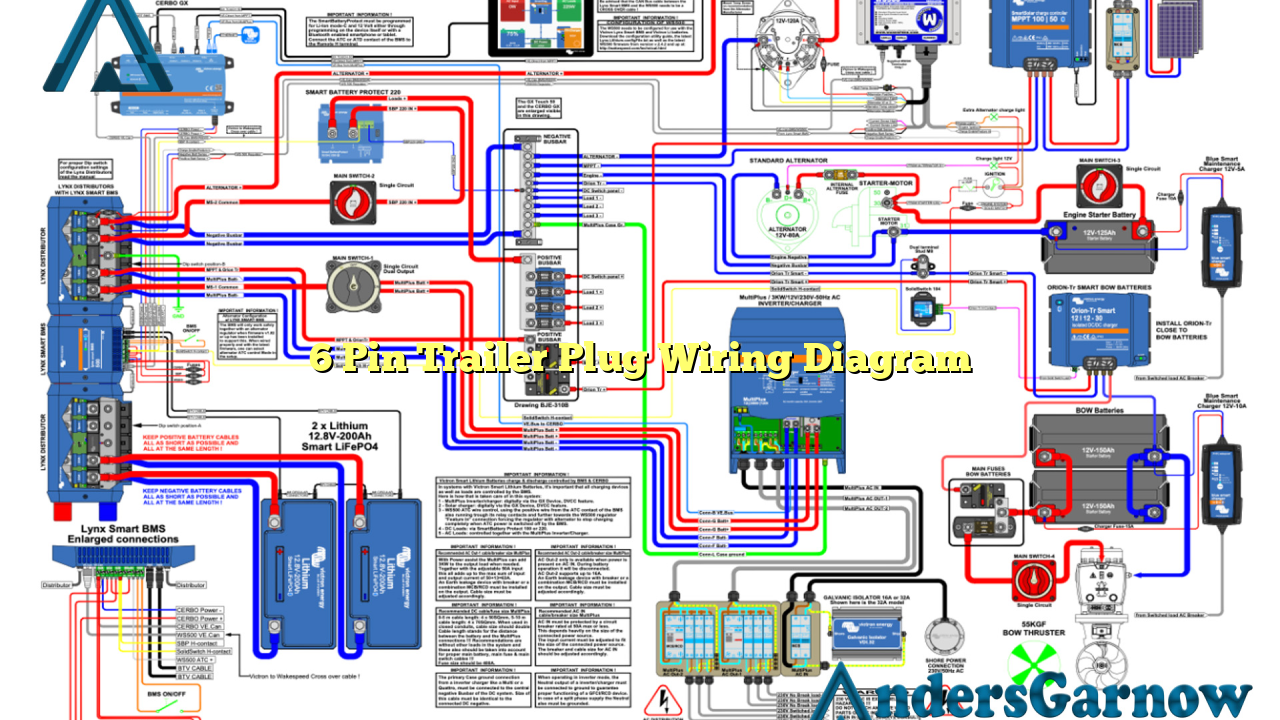
Troubleshooting 6-Pin Trailer Plug Wiring Issues: A Comprehensive Guide
The open road beckons, promising adventure and the freedom to explore. But before you hit the highway with your trailer in tow, ensuring the proper functionality of your 6-pin trailer plug is paramount. A malfunctioning trailer plug can lead to a cascade of problems, from non-functioning lights to, more seriously, compromised safety. This comprehensive guide delves into the common 6-pin trailer plug wiring issues, equipping you with the knowledge and tools to diagnose and resolve them effectively. We’ll explore the intricacies of trailer wiring, demystify the color-coding, and provide practical troubleshooting steps to get you back on the road safely and confidently.
Understanding the 6-Pin Trailer Plug: A Quick Overview
Before diving into troubleshooting, it’s crucial to understand the basic components of a 6-pin trailer plug and its purpose. This plug acts as the vital link between your vehicle and your trailer, transmitting electrical signals to power the trailer’s lights (brake lights, turn signals, and running lights) and potentially other accessories like electric brakes. The 6-pin configuration is a standard for many trailers, offering a streamlined and reliable connection.
Each pin within the 6-pin trailer plug corresponds to a specific electrical function. While the exact color-coding can vary slightly depending on the manufacturer, the general layout remains consistent. Understanding this layout is the first step toward effective troubleshooting. A typical 6-pin configuration includes:
- Ground: Typically white, providing a return path for the electrical current.
- Left Turn Signal/Brake: Typically yellow, activating the left turn signal and brake light on the trailer.
- Right Turn Signal/Brake: Typically green, activating the right turn signal and brake light on the trailer.
- Running Lights: Typically brown, powering the trailer’s running lights (also known as tail lights).
- Electric Brake: Typically blue, providing power to the trailer’s electric brakes (if equipped).
- Reverse Lights: Typically purple or black, powering the trailer’s reverse lights (if equipped).
Common 6-Pin Trailer Plug Wiring Issues and Their Causes
Several factors can contribute to 6-pin trailer plug wiring issues. Identifying the underlying cause is critical for a successful repair. Here are some of the most prevalent problems:
Corrosion and Oxidation
Exposure to the elements, including rain, snow, and road salt, can lead to corrosion within the 6-pin trailer plug and the corresponding socket on your vehicle. Corrosion creates a barrier to electrical current flow, causing lights to flicker, fail, or function erratically. Oxidation is a similar problem, where oxygen reacts with the metal contacts, forming an insulating layer.
Loose or Damaged Wiring
Over time, vibrations and movement can loosen the wires connected to the 6-pin trailer plug or within the trailer’s wiring harness. This can result in intermittent connections or complete loss of power to specific circuits. Physical damage, such as cuts, abrasions, or pinched wires, can also disrupt the electrical flow.
Faulty Trailer Lights
A burned-out bulb, a short circuit within the trailer’s light fixtures, or a problem with the trailer’s internal wiring can all manifest as 6-pin trailer plug wiring issues. It’s essential to rule out problems within the trailer’s light system before focusing solely on the plug.
Problems within the Vehicle’s Wiring
The vehicle’s wiring harness, which connects to the 6-pin trailer plug socket, can also be the source of problems. Blown fuses, damaged wiring, or faulty relays within the vehicle’s electrical system can prevent power from reaching the trailer. This is often overlooked, so it’s important to check the vehicle’s wiring as part of the diagnostic process.
Grounding Issues
A poor ground connection is a common culprit behind various electrical problems. If the ground wire connection within the 6-pin trailer plug or the trailer’s chassis is corroded, loose, or broken, the electrical circuit cannot complete its path, leading to malfunctioning lights or other issues. A good ground is absolutely essential.
Troubleshooting Steps for 6-Pin Trailer Plug Wiring Issues
Now that we’ve identified the potential causes, let’s delve into the practical steps for troubleshooting 6-pin trailer plug wiring issues:
Step 1: Inspection and Visual Examination
Begin with a thorough visual inspection of both the 6-pin trailer plug and the vehicle’s socket. Look for signs of corrosion, damage, or loose wires. Check for any obvious breaks or cuts in the wiring. Ensure that the pins within the plug are clean and free of debris. If corrosion is present, you’ll need to clean the contacts thoroughly.
Step 2: Cleaning Corroded Contacts
If you find corrosion, use a wire brush or a specialized contact cleaner spray to remove it. Be meticulous in cleaning the pins of the 6-pin trailer plug and the corresponding contacts in the vehicle’s socket. After cleaning, apply a small amount of dielectric grease to the contacts to help prevent future corrosion. This is a crucial step in addressing many 6-pin trailer plug wiring issues.
Step 3: Testing with a Multimeter
A multimeter is an invaluable tool for diagnosing electrical problems. Set the multimeter to measure DC voltage. With the trailer connected to the vehicle and the vehicle’s lights activated (running lights, turn signals, brake lights), test the voltage at each pin of the 6-pin trailer plug. Compare the readings to the expected voltage for each function. If you’re not getting the correct voltage, it indicates a problem within that circuit. For instance, if you’re not getting voltage at the brake light pin, the issue is likely with the vehicle’s brake light circuit, the trailer’s brake light, or the wiring connecting them. Remember to test the ground connection to ensure it’s providing a solid return path.
Step 4: Checking Fuses
Locate the fuse box in your vehicle and check the fuses related to the trailer lights. Refer to your vehicle’s owner’s manual to identify the correct fuses. If a fuse is blown, replace it with a fuse of the same amperage rating. Blown fuses are a common symptom of 6-pin trailer plug wiring issues, often caused by a short circuit.
Step 5: Examining the Trailer Lights
Disconnect the trailer from the vehicle and inspect the trailer’s lights. Check for burned-out bulbs and replace them as needed. Examine the wiring within the trailer’s light fixtures for any signs of damage or shorts. Use a multimeter to test the circuits within the trailer’s light system to identify any faults.
Step 6: Inspecting Wiring and Connections
Carefully examine the wiring harness leading to the 6-pin trailer plug, both on the vehicle and the trailer. Look for any loose connections, damaged wires, or areas where the insulation has worn away. Repair any damaged wiring by splicing in new wire and using heat-shrink tubing to protect the connections. Ensure all connections are secure and properly insulated. Pay close attention to the ground connections, ensuring they are clean and tightly secured.
Step 7: Testing the Vehicle’s Wiring
If you suspect a problem within the vehicle’s wiring, you may need to consult your vehicle’s owner’s manual or a qualified mechanic. Check the wiring harness leading to the 6-pin trailer plug socket for any damage or loose connections. Verify that the vehicle’s relays and other electrical components related to the trailer lights are functioning correctly.
Step 8: Seeking Professional Assistance
If you’ve exhausted these troubleshooting steps and are still experiencing problems, it’s time to seek professional assistance. A qualified auto electrician can diagnose and repair complex 6-pin trailer plug wiring issues more effectively. They have the expertise and specialized tools to identify and resolve even the most challenging electrical problems.
Preventive Maintenance for 6-Pin Trailer Plugs
Preventing 6-pin trailer plug wiring issues is easier than dealing with them after they arise. Here are some tips to maintain your trailer plug and ensure its long-term reliability:
- Regular Inspection: Inspect your 6-pin trailer plug and socket regularly for corrosion, damage, or loose connections.
- Cleaning: Clean the contacts with a wire brush or contact cleaner spray periodically, especially before and after the towing season.
- Dielectric Grease: Apply dielectric grease to the contacts to help prevent corrosion.
- Protective Covers: Use a protective cover on the 6-pin trailer plug when not in use to shield it from the elements.
- Wiring Inspection: Regularly inspect the wiring harness for any signs of damage or wear.
- Professional Checkups: Consider having a qualified mechanic inspect your trailer’s wiring system periodically.
Conclusion: Keeping Your Trailer Lights Shining Bright
Troubleshooting 6-pin trailer plug wiring issues can seem daunting, but with a systematic approach and a little patience, you can often diagnose and resolve the problems yourself. By understanding the basic components, identifying common causes, and following the troubleshooting steps outlined in this guide, you can keep your trailer lights functioning correctly and ensure your safety on the road. Remember to prioritize safety and seek professional assistance if you’re unsure about any aspect of the repairs. Regular maintenance and preventive measures are key to avoiding future 6-pin trailer plug wiring issues and enjoying trouble-free towing for years to come. Maintaining a functional 6-pin trailer plug is not just about convenience; it’s about safety and responsible driving. Take the time to understand your trailer’s electrical system, and you’ll be well-equipped to handle any challenges that may arise.
[See also: Trailer Brake Troubleshooting, Understanding Trailer Wiring Diagrams, How to Install a Trailer Hitch]


